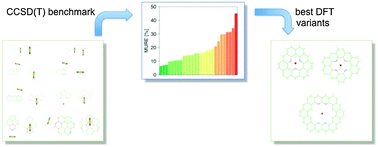An accurate benchmark description of the interactions between carbon dioxide and polyheterocyclic aromatic compounds containing nitrogen†
Abstract
We assessed the performance of a large variety of modern density functional theory approaches for the adsorption of carbon dioxide on molecular models of pyridinic N-doped graphene. Specifically, we selected eight polyheterocyclic aromatic compounds ranging from pyridine and pyrazine to 1,6-diazacoronene and investigated their complexes with CO2 for a large range of intermolecular distances and including both in-plane and stacked orientations. The benchmark interaction energies were computed at the complete-basis-set limit MP2 level plus a CCSD(T) coupled-cluster correction in a moderate but carefully selected basis set. Using a set of 96 benchmark CCSD(T)-level interaction energies as a reference, we investigated the accuracy of DFT-based approaches as a function of the density functional, the dispersion correction, the basis set, and the counterpoise correction or lack thereof. While virtually all DFT variants exhibit some deterioration of accuracy for distances slightly shorter than the van der Waals minima, we were able to identify several schemes such as B2PLYP-D3 and M05-2X-D3 whose average errors on the entire benchmark data set are in the 5–10% range. The top DFT performers were subsequently used to investigate the energy profile for a carbon dioxide transition through model N-doped graphene pores. All investigated methods confirmed that the largest, N4H4 pore allows for a barrierless CO2 transition to the other side of a graphene sheet.


 Please wait while we load your content...
Please wait while we load your content...